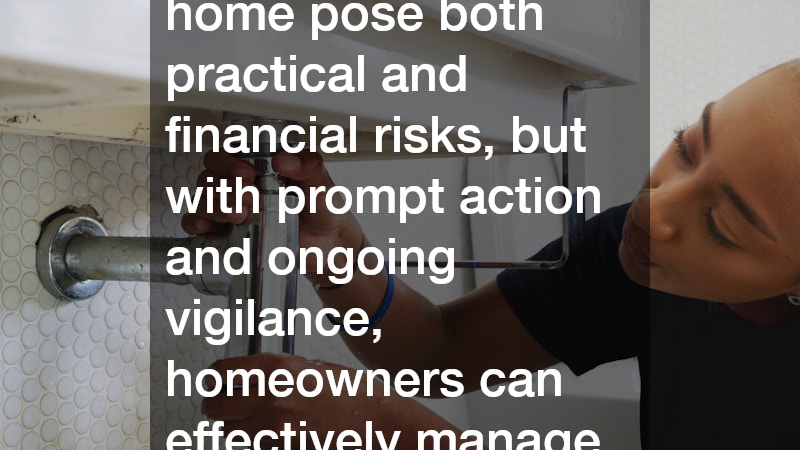Water leaks in the home are more than just a nuisance—they can lead to structural damage, mould growth and costly utility bills if left unresolved. Whether the leak is hidden in the walls or visibly dripping from a pipe, early detection and prompt repair are essential.
Understanding the common signs and causes of water leaks, along with effective strategies to fix them, can help protect your property and preserve your peace of mind.
Understanding the Causes of Water Leaks
Water leaks can stem from various sources within the home, many of which are not immediately visible. Ageing pipes are one of the most common culprits, particularly in older properties where metal piping corrodes over time. In newer homes, poor workmanship or substandard materials during construction can also lead to faulty pipework and joints. External factors such as shifting soil or tree roots invading underground lines may disrupt plumbing, leading to unnoticed leaks until significant damage has occurred.
The home’s roofing, gutters and external walls are also potential entry points for water, especially after heavy rain. If the home is not adequately sealed or the roof tiles are damaged, water can seep in and cause internal dampness that mimics the symptoms of a plumbing leak. Understanding that not all water leaks originate from plumbing systems is crucial in narrowing down the source of an issue.
Identifying the Early Warning Signs
Detecting water leaks early can prevent extensive damage. One of the clearest indicators is an unexpected spike in the water bill, which suggests excessive usage due to a hidden leak. Damp or discoloured patches on walls, ceilings, or floors may indicate a slow leak behind the surface. Musty odours are another sign, often pointing to mould or mildew growth as a result of excess moisture.
Other clues include the sound of running water when no taps are turned on, or a drop in water pressure that might suggest a breach in the plumbing. In bathrooms and kitchens, check under sinks and behind appliances for pooling water or warped cabinetry. Outside, unexplained puddles, lush patches of grass, or subsiding ground can be signs of underground water leaks that require immediate attention.
Practical Steps to Locate Leaks
Homeowners can take several proactive steps to locate water leaks. Begin by checking the water meter. Turn off all water-using appliances and taps, then monitor the meter to see if it continues to move. If it does, this confirms that a leak is present within the system.
Visual inspections are also valuable. Check accessible areas such as under sinks, behind the toilet and in the laundry for signs of moisture or corrosion. Tapping on walls to detect hollow sounds, or using a thermal imaging camera, can help identify hidden leaks. For roof and gutter issues, conduct a visual inspection during or after rainfall to see if water is entering the home or overflowing incorrectly.
Effective Methods for Repairing Water Leaks
The method used to fix water leaks depends on the severity and location of the problem. Minor leaks under sinks or in exposed pipes can often be resolved with simple solutions such as tightening connections, replacing washers, or applying plumber’s tape. Cracked or broken pipes may require cutting out the damaged section and replacing it with a new length of pipe using proper couplings.
In cases where leaks are inside walls or ceilings, more invasive repairs might be needed. A qualified plumber can help to isolate and fix the issue with minimal disruption, using specialised equipment to avoid unnecessary damage to the structure.
Long-Term Prevention and Maintenance
Preventing water leaks requires a combination of regular maintenance and attentive care. Schedule periodic plumbing inspections to catch wear and tear before it leads to failure. Replace ageing pipes and worn seals proactively rather than waiting for leaks to occur. Ensure all roof drainage systems are cleaned and maintained to prevent overflow or pooling water near the foundation.
Insulating pipes in colder regions can prevent freezing and cracking, while installing leak detection devices can alert homeowners to issues in real time. These smart sensors are particularly useful in high-risk areas like basements, under sinks and behind washing machines, offering a layer of protection even when no one is home.
When to Call a Professional
While some water leaks can be managed with basic tools and knowledge, more serious cases require the expertise of a licensed plumber. If the source of the leak is not obvious, or if water damage is widespread, professional intervention ensures a thorough and lasting solution. Delaying repairs can exacerbate the damage and increase the cost of restoration.
In some situations, insurance may cover the cost of repairs and water damage, provided the issue is reported promptly. Always document the leak and any repairs undertaken to support a potential claim.
Water leaks in the home pose both practical and financial risks, but with prompt action and ongoing vigilance, homeowners can effectively manage and prevent them. From spotting the early signs and conducting simple checks to making informed repair decisions, taking a proactive approach to water leaks protects not just the structure of the home, but the health and comfort of everyone living inside. Regular maintenance, professional support and a watchful eye go a long way in ensuring a safe, dry and damage-free environment.

